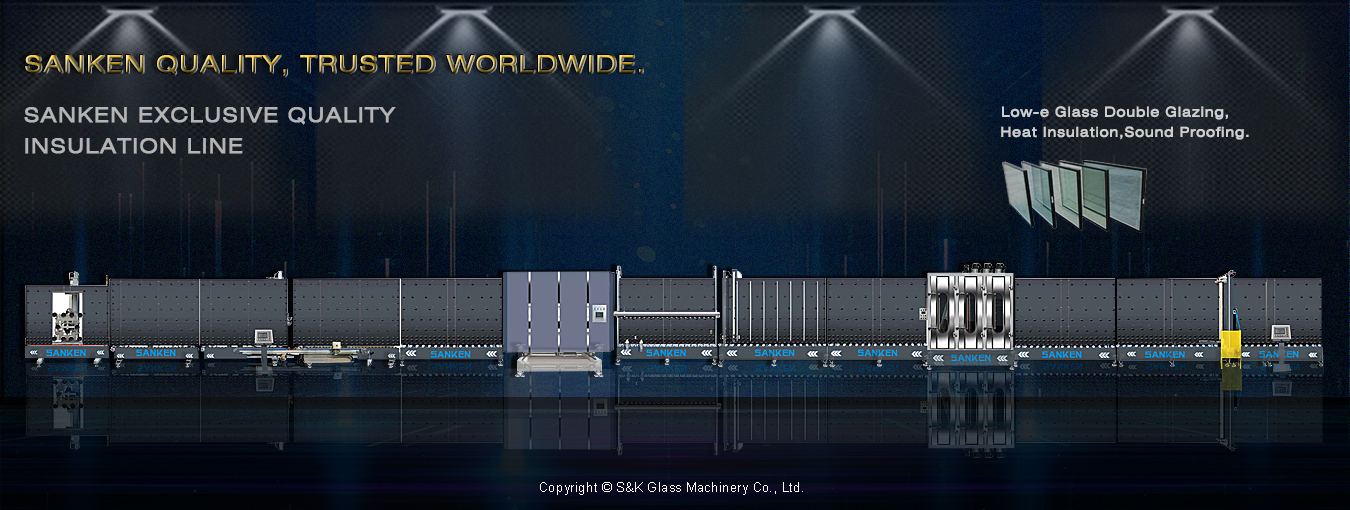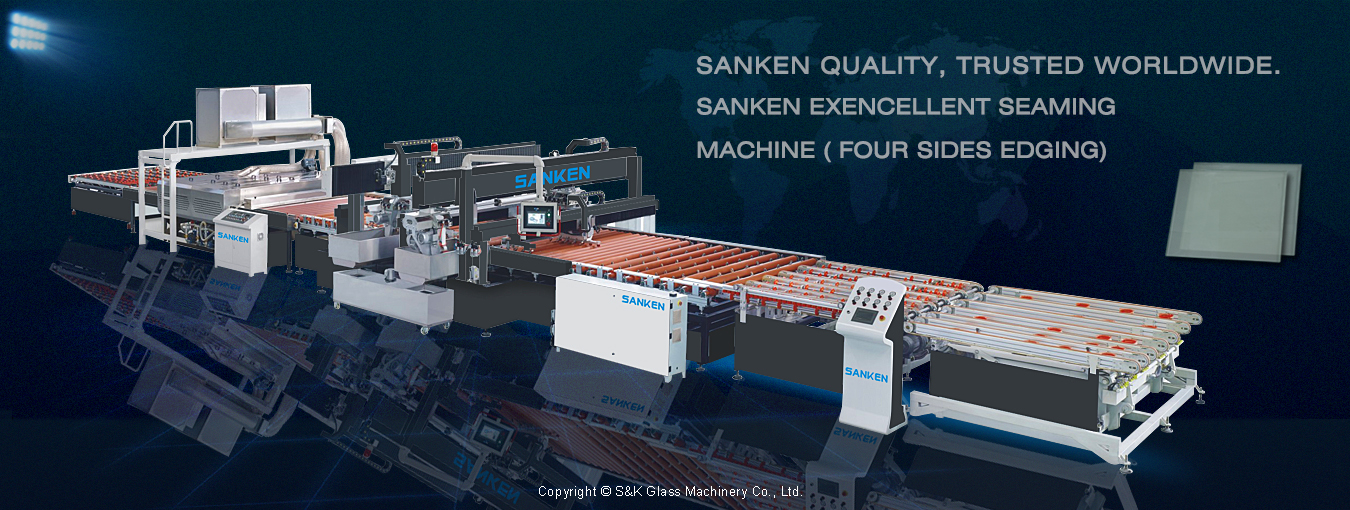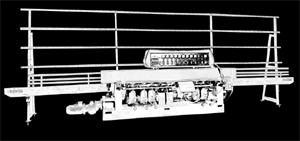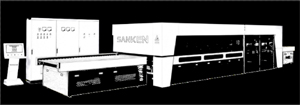清洗机的保养
Maintenance on glass washing machine
Mantenimiento en lavadora de vidrio
Entretien sur machine à laver le verre
Обслуживание на стиральной машине
صيانة غسالة الزجاج
1、开机前检查输送辊上是否存在杂物,对碎玻璃等杂物进行清理。
2、玻璃清洗机装有海绵棒,应检查其是否过硬或者是吸水过多,如有异物则需及时清理。海绵棒过硬时应手动注入清洗水,必要时用手帮助发软,必须吸水到整体柔软状态,局部柔软是不正确的,如水分过多则用手拧干海绵棒。一旦发现海绵棒上有异物,则应用水清洗干净,以利于海绵棒吸水性(该装置为选用部分)。
3、温控器应该控制在55-70°之间,不易调高(该加热装置为选用部分)。
4、变速器使用专用润滑油,开机前检查油位是否达到油镜中间。
5、应定期检查各传动链条及齿轮的松紧配合程度,必要时作相应调整及钙基润滑脂。切记一定要杜绝润滑油或润滑脂掉至中间工作部分或滴入水箱、水盘中。
6、每工作班次后应注水箱水位及清洁水箱、水盘、过滤网,并每工作1-3天要更换一次谁,以保水质。
7、玻璃清洗机不干净。玻璃原片完成整个清洗及干燥工作流程,发现下片的玻璃表面存在污垢。此时应注意检查是否是玻璃厚度减小的时候,没有及时调整毛刷高度导致毛刷对玻璃表面洗刷力度不足;或者检查机械出水量是否不足,及时添加水量;或者重新调整毛刷出的出水量,加大出水量即可。
8、玻璃清洗后出现很多细小粉尘。此种情况下建议第一时间检查是否是毛刷出了问题,如果毛刷过脏或者过滤装置破损都会出现这种清洗后仍存在细小粉尘的情况。处理方法是对脏的毛刷进行冲洗,破损的过滤器进行修补,如无法修补则更换新的过滤装置。
9、玻璃干燥不彻底。玻璃在风干段进行风干后输送到下片区,已经完成风干操作,但是玻璃表面仍存在水珠。导致此现象极可能是风刀位置或角度不当,重新调整。
1. Check whether there is debris on the conveyor roller before starting, and clean up debris such as broken glass.
2. The glass cleaning machine is equipped with a sponge stick. It should be checked whether it is too hard or it absorbs too much water. If there is any foreign object, it should be cleaned in time. Sponge sticks should be filled with washing water manually when necessary. If necessary, help to soften by hand. It must absorb water to the overall soft state. Local softening is not correct. If there is too much water, wring the sponge sticks by hand. Once a foreign object is found on the sponge stick, it should be cleaned with water to help the sponge stick absorb water (this device is an optional part).
3. The temperature controller should be controlled between 55-70 °, and it is not easy to adjust the height (the heating device is an optional part).
4. The transmission uses special lubricating oil. Check whether the oil level reaches the middle of the oil mirror before starting.
5. The tightness of each transmission chain and gear should be checked regularly, and if necessary, make adjustments and calcium-based grease. Remember to prevent the lubricating oil or grease from falling into the middle working part or dripping into the water tank or water tray.
6. After each work shift, the water level of the water tank and the water tank, water pan, and filter screen should be cleaned, and who should be replaced every 1-3 days to maintain water quality.
7. The glass washer is not clean. The original glass piece completed the entire cleaning and drying workflow, and it was found that there was dirt on the glass surface of the next piece. At this time, you should pay attention to check whether the thickness of the glass is reduced, and the height of the brush is not adjusted in time to cause the brush to scrub the glass surface insufficiently; or whether the mechanical water output is insufficient, add water in time; Water volume, just increase the water output.
8. A lot of fine dust appeared after the glass was cleaned. In this case, it is recommended to check whether the brush is faulty at the first time. If the brush is dirty or the filter device is damaged, there will be fine dust after cleaning. The treatment method is to rinse the dirty brush, repair the damaged filter, and replace it with a new filter device if it cannot be repaired.
9. The glass does not dry completely. The glass is dried in the air-drying section and then transported to the lower film area. The air-drying operation has been completed, but there are still water droplets on the glass surface. The most likely cause of this phenomenon is the improper position or angle of the air knife, and readjust it.
1. Verifique si hay restos en el rodillo transportador antes de comenzar, y limpie los restos como vidrios rotos.
2. La máquina de limpieza de vidrio está equipada con una esponja. Debe comprobarse si es demasiado duro o si absorbe demasiada agua. Si hay algún objeto extraño, debe limpiarse a tiempo. Los palitos de esponja deben llenarse con agua de lavado manualmente cuando sea necesario. Si es necesario, ayuda a suavizar a mano. Debe absorber agua al estado general suave. El ablandamiento local no es correcto. Si hay demasiada agua, escurra los palitos de esponja a mano. Una vez que se encuentra un objeto extraño en la esponja, se debe limpiar con agua para ayudar a que la esponja absorba agua (este dispositivo es una parte opcional).
3. El controlador de temperatura debe controlarse entre 55-70 °, y no es fácil ajustar la altura (el dispositivo de calentamiento es una parte opcional).
4. La transmisión utiliza aceite lubricante especial. Compruebe si el nivel de aceite alcanza la mitad del espejo de aceite antes de comenzar.
5. La estanqueidad de cada cadena de transmisión y engranaje debe verificarse regularmente y, si es necesario, hacer ajustes y grasa a base de calcio. Recuerde evitar que el aceite lubricante o la grasa caigan en la parte de trabajo del medio o goteen en el tanque de agua o la bandeja de agua.
6. Después de cada turno de trabajo, se debe limpiar el nivel de agua del tanque de agua y el tanque de agua, la bandeja de agua y la pantalla del filtro, y quién se debe reemplazar cada 1-3 días para mantener la calidad del agua.
7. La lavadora de vidrio no está limpia. La pieza de vidrio original completó todo el flujo de trabajo de limpieza y secado, y se descubrió que había suciedad en la superficie de vidrio de la siguiente pieza. En este momento, debe prestar atención para verificar si se reduce el grosor del vidrio y si la altura del cepillo no se ajusta a tiempo para hacer que el cepillo frote la superficie del vidrio de manera insuficiente; o si la salida mecánica de agua es insuficiente, agregue agua a tiempo; Volumen de agua, solo aumente la salida de agua.
8. Después de limpiar el vidrio, apareció mucho polvo fino. En este caso, se recomienda verificar si el cepillo está defectuoso por primera vez. Si el cepillo está sucio o el dispositivo de filtro está dañado, habrá polvo fino después de la limpieza. El método de tratamiento es enjuagar el cepillo sucio, reparar el filtro dañado y reemplazarlo con un nuevo dispositivo de filtro si no se puede reparar.
9. El vidrio no se seca por completo. El vidrio se seca en la sección de secado al aire y luego se transporta al área inferior de la película. La operación de secado al aire se ha completado, pero todavía hay gotas de agua en la superficie del vidrio. La causa más probable de este fenómeno es la posición o ángulo incorrecto de la cuchilla de aire y reajustarlo.
1. Vérifiez s'il y a des débris sur le rouleau du convoyeur avant de démarrer et nettoyez les débris tels que le verre brisé.
2. La machine de nettoyage de vitres est équipée d'un bâton éponge. Il faut vérifier s'il est trop dur ou s'il absorbe trop d'eau. S'il y a un objet étranger, il doit être nettoyé à temps. Les bâtons éponge doivent être remplis d'eau de lavage manuellement si nécessaire. Si nécessaire, aidez à ramollir à la main. Il doit absorber l'eau jusqu'à l'état mou global. L'adoucissement local n'est pas correct. S'il y a trop d'eau, essorez les bâtons d'éponge à la main. Une fois qu'un corps étranger a été trouvé sur le bâton éponge, il doit être nettoyé avec de l'eau pour aider le bâton éponge à absorber l'eau (cet appareil est une pièce en option).
3. Le régulateur de température doit être contrôlé entre 55 et 70 °, et il n'est pas facile de régler la hauteur (le dispositif de chauffage est une pièce en option).
4. La transmission utilise une huile lubrifiante spéciale. Vérifiez si le niveau d'huile atteint le milieu du miroir d'huile avant de commencer.
5. L'étanchéité de chaque chaîne de transmission et de chaque engrenage doit être vérifiée régulièrement et, si nécessaire, effectuer des réglages et de la graisse à base de calcium. N'oubliez pas d'éviter que l'huile ou la graisse de lubrification ne tombe dans la partie centrale de travail ou ne coule dans le réservoir ou le bac à eau.
6. Après chaque quart de travail, le niveau d'eau du réservoir d'eau et du réservoir d'eau, du bac à eau et du filtre doit être nettoyé et qui doit être remplacé tous les 1 à 3 jours pour maintenir la qualité de l'eau.
7. La rondelle de verre n'est pas propre. La pièce en verre d'origine a terminé l'ensemble du flux de travail de nettoyage et de séchage, et il a été constaté qu'il y avait de la saleté sur la surface en verre de la pièce suivante. À ce stade, vous devez faire attention à vérifier si l'épaisseur du verre est réduite et si la hauteur de la brosse n'est pas réglée à temps pour que la brosse frotte insuffisamment la surface du verre; ou si le débit d'eau mécanique est insuffisant, ajoutez de l'eau à temps; Volume d'eau, augmentez simplement le débit d'eau.
8. De nombreuses poussières fines sont apparues après le nettoyage de la vitre. Dans ce cas, il est recommandé de vérifier si la brosse est défectueuse lors de la première utilisation. Si la brosse est sale ou le filtre est endommagé, il y aura de la poussière fine après le nettoyage. La méthode de traitement consiste à rincer la brosse sale, à réparer le filtre endommagé et à le remplacer par un nouveau dispositif de filtre s'il ne peut pas être réparé.
9. Le verre ne sèche pas complètement. Le verre est séché dans la section de séchage à l'air puis transporté vers la zone de film inférieure. L'opération de séchage à l'air est terminée, mais il reste des gouttelettes d'eau à la surface du verre. La cause la plus probable de ce phénomène est la position ou l'angle incorrect du couteau à air, et réajustez-le.
1. Перед запуском проверьте, нет ли на конвейере роликов, и очистите их, например, разбитое стекло.
2. Машина для очистки стекла оснащена губкой. Следует проверить, является ли он слишком твердым или поглощает слишком много воды. Если есть какой-либо посторонний предмет, он должен быть вовремя очищен. Губки следует при необходимости вручную наполнять водой для мытья. При необходимости помогите смягчить вручную. Он должен впитывать воду до общего мягкого состояния. Местное смягчение не является правильным. Если воды слишком много, отожмите губку ручками. Когда на губчатой палочке обнаружен посторонний предмет, его следует очистить водой, чтобы губчатая палочка впитала воду (это устройство является дополнительной деталью).
3. Регулятор температуры должен регулироваться в пределах 55-70 °, и отрегулировать высоту нелегко (нагревательное устройство является дополнительной деталью).
4. В трансмиссии используется специальное смазочное масло. Перед началом работы проверьте, достигает ли уровень масла середины масляного зеркала.
5. Герметичность каждой трансмиссионной цепи и передачи следует регулярно проверять, а при необходимости вносить коррективы и смазку на основе кальция. Помните, что смазочное масло или смазка не должны попадать в среднюю рабочую часть или капать в емкость для воды или поддон для воды.
6. После каждой рабочей смены уровень воды в резервуаре для воды и резервуаре для воды, поддоне для воды и сетке фильтра следует очищать, и их следует заменять каждые 1-3 дня для поддержания качества воды.
7. Стеклоочиститель не чистый. Оригинальный кусок стекла завершил весь процесс очистки и сушки, и было обнаружено, что на поверхности стекла следующего куска была грязь. В это время следует обратить внимание на то, чтобы проверить, не уменьшена ли толщина стекла и не отрегулирована ли высота щетки во времени, чтобы кисть не вычищала поверхность стекла; или если механическая подача воды недостаточна, добавляйте воду вовремя; Объем воды, просто увеличьте выход воды.
8. После очистки стекла появилось много мелкой пыли. В этом случае рекомендуется проверить, не повреждена ли щетка в первый раз. Если щетка грязная или фильтрующее устройство повреждено, после очистки будет мелкая пыль. Метод лечения состоит в том, чтобы промыть грязную щетку, отремонтировать поврежденный фильтр и заменить его новым фильтрующим устройством, если его невозможно починить.
9. Стекло не высыхает полностью. Стекло сушат в секции воздушной сушки, а затем транспортируют в нижнюю зону пленки. Операция воздушной сушки завершена, но на поверхности стекла все еще остаются капли воды. Наиболее вероятная причина этого явления - неправильное положение или угол наклона воздушного ножа, и перенастройте его.
1. تحقق مما إذا كان هناك حطام على الأسطوانة الناقلة قبل البدء ، وقم بتنظيف الحطام مثل الزجاج المكسور.
2. آلة تنظيف الزجاج مزودة بعصا إسفنجية. يجب التحقق مما إذا كان صعبًا جدًا أو يمتص الكثير من الماء. إذا كان هناك أي شيء غريب ، فيجب تنظيفه في الوقت المناسب. يجب تعبئة العصي الإسفنجية بغسل الماء يدويًا عند الضرورة. إذا لزم الأمر ، ساعد على تليين اليد. يجب أن يمتص الماء إلى الحالة اللينة الشاملة. التليين المحلي غير صحيح. إذا كان هناك الكثير من الماء ، قم بفك العصي الإسفنجية باليد. بمجرد العثور على جسم غريب على عصا الإسفنج ، يجب تنظيفه بالماء لمساعدة عصا الإسفنج على امتصاص الماء (هذا الجهاز هو جزء اختياري).
3. يجب التحكم في جهاز التحكم في درجة الحرارة بين 55-70 درجة ، وليس من السهل ضبط الارتفاع (جهاز التسخين هو جزء اختياري).
4. يستخدم ناقل الحركة زيت التشحيم الخاص. تحقق مما إذا كان مستوى الزيت يصل إلى منتصف مرآة الزيت قبل البدء.
5. يجب فحص ضيق كل سلسلة ناقل الحركة والعتاد بانتظام ، وإذا لزم الأمر ، قم بإجراء التعديلات والشحوم القائمة على الكالسيوم. تذكر أن تمنع زيت التشحيم أو الشحم من السقوط في جزء العمل الأوسط أو يقطر في خزان الماء أو صينية الماء.
6. بعد كل نوبة عمل ، يجب تنظيف مستوى المياه لخزان المياه وخزان الماء ، ووعاء الماء ، وشاشة المرشح ، والذين يجب استبدالهم كل 1-3 أيام للحفاظ على جودة المياه.
7. غسالة الزجاج ليست نظيفة. أكملت القطعة الزجاجية الأصلية سير عمل التنظيف والتجفيف بالكامل ، ووجد أن هناك تراب على السطح الزجاجي للقطعة التالية. في هذا الوقت ، يجب الانتباه إلى ما إذا كان سمك الزجاج منخفضًا ، ولا يتم تعديل ارتفاع الفرشاة في الوقت المناسب حتى تتسبب الفرشاة في فرك السطح الزجاجي بشكل غير كافٍ ؛ أو إذا كان الناتج الميكانيكي للمياه غير كافٍ ، أضف الماء في الوقت المناسب ؛ حجم الماء ، فقط زيادة إخراج المياه.
8. ظهر الكثير من الغبار الناعم بعد تنظيف الزجاج. في هذه الحالة ، يوصى بالتحقق مما إذا كانت الفرشاة معيبة في المرة الأولى. إذا كانت الفرشاة متسخة أو تلف جهاز المرشح ، فسيكون هناك غبار ناعم بعد التنظيف. طريقة العلاج هي شطف الفرشاة المتسخة ، وإصلاح المرشح التالف ، واستبداله بجهاز مرشح جديد إذا لم يكن بالإمكان إصلاحه.
9. الزجاج لا يجف تماما. يتم تجفيف الزجاج في قسم تجفيف الهواء ثم نقله إلى منطقة الطبقة السفلية. تم الانتهاء من عملية تجفيف الهواء ، ولكن لا تزال هناك قطرات ماء على السطح الزجاجي. السبب الأكثر احتمالا لهذه الظاهرة هو الموقف غير المناسب أو زاوية سكين الهواء ، وتعديلها.
 中文
中文
 English
English
 español
español
 Français
Français
 русский язык
русский язык
 عربية
عربية











